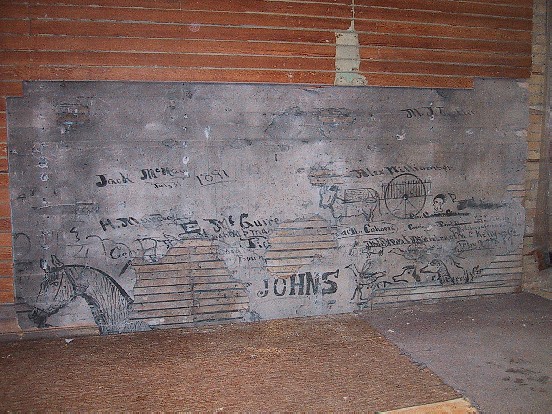|
|
|
|
175 McDermot (Special)

On Thursday February 14, 2008, Jon Thiessen and his staff at U.N. Luggage had begun renovations on the Mezzanine level of his store when they uncovered this intriguing discovery: an 1889 graffiti style plaster wall, and a piece of Red River history.
Jon Thiessen: “We started peeling back these wood slats, the eventual goal of getting rid of the plaster to get to the brick. The first thing we saw was the signature at the top right, M.J. Rublee (Photo 2). I’m guessing here, but at one time this floor that we’re standing on was the height of the main floor (4 feet lower), so to reach this high he would have used something like a milk crate to stand on so that his signature would be higher than everyone else’s.”
As Jon and staff continued to remove the slats, the full scope of their discovery was revealed, with names (Jack McKay, H Murdoff, E.J. McGuire, Jack Cahoon, M.C. Kelley, Alex Williamson, M.J. Rublee) dates, and reasonably artistic sketches of a horse’s head and neck (Photo 3), a Red River cart (Photo 4), a pig, ducks, birds and assorted animals (Photo 5). At one place on the wall, a man wrote ‘coming from Point Douglass (sic) and met a broad after a hoedown.’ (Photo 6).
Jon: “With all of the buildings in this neighbourhood, the brick would have been covered up with plaster. Brick wasn’t ‘heritage’ back then- it would have looked like an unfinished wall. To finish it they would have framed it and plastered it- more or less comparable to drywalling today. My theory is that some of the men who plastered this wall would have been the ones who did the writings and drawings. There wouldn’t have been a plaster wall outside, so there would be limited access to it to others.”
”This building is now a heritage building. It was built in the 1880’s as a 3 storey warehouse. This upper level floor was added in 1910, but that would have been after this artwork was done.”
Thiessen believes that these original drawings probably extended all the way (four feet further) down to the main floor, but would have been destroyed during that 1910 renovation.
“I don’t know if it was ink or paint or if it was just coal or charcoal and water mixed together to paint this, but they did a pretty neat job- it’s neatly done.”
A close inspection of the wall reinforces the ‘neatness’ idea. Where most of the various signatures are, one can clearly see that a line had first been drawn with a straight edge; and that all of the writings are placed neatly on the line. The signatures themselves are rather neat and tidy in penmanship, and some appear to be expressed in one particular font or other. Most of the underlined writings on the wall, although by different hands, share the common characteristic of slanting to the left, the opposite of italics.
One curiousity about the wall involves a depiction of a person’s head in what appears to be a strong headwind with his hat blown off his head (Photo 6). Another involves the date accompanying one of the signatures of February 29th, 1889 (also Photo 6). A quick check reveals that 1889 was in fact NOT a leap year, though 1888 had been. It is extremely unlikely that the writer had the year confused, but rather the day, which would effectively have been March 1. Men who worked in the trades back then often had little or less education than now, and such an error would be quite understandable.
|
Displaying Photos 1-3 of 6
|
|